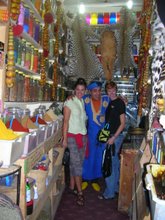Acquiring a Taste for the Orient.
Article 5
From Peking duck in Beijing to piping hot curries in Thailand our pallets are getting a work out. Every culture seems to embrace their own flair in the kitchen, or street cart if you will. We are sampling everything. Curiosity never killed any of my cats, though I may have eaten one recently (unknowingly). By no means am I a food expert, but I now know the difference between Low Main and Chow main. And yes, both Lisa and I are now certified "Thai Culinary Artists;" maybe one day I will make you Pad Thai and Lisa can garnish it with a lotus flower made from an onion. (May look as sweet as a rose but will surely bring a tear to your eye.)
The Chinese have several styles of cooking, and keeping it all straight can be as confusing as understanding the language. Here are the basics. For one, Cantonese from the south-west of China is what Americans are most familiar with. Some favorites you might recognize would be sweet and sour pork, sesame chicken and Dim Sum. Dim Sum is the typical brunch consisting of a variety of dumplings filled with savory or sweet goodies delivered to your table via cart. Sichanese is a style from the west of China that is usually piping hot and is made with flower peppers, ginger and peanuts, like Kung Pao Pork. The North is famous for Roast Peking Duck and noddle dishes. The cooking styles and flavors are diverse but all are accompanied with tea and eaten with chopsticks.
Using chop sticks can be quite a formidable task but practice and hunger can shorten the learning curve. The style, shape and material used to make chopsticks vary between countries but the concept is the same. The real rule of thumb is to use your thumb and forefinger to move only the top stick. Meals are always served family style, so everyone can try a few main dishes. As for when a bowl of egg-drop soup is presented and no cutlery to be had what's a civilized girl to do? Just pick up your bowl and slurp away, the louder the better. The alternative is to eat the "street meat" sold on a stick, which could be anything from a mysterious looking sausage to a whole octopus (choose the sausage- less rubbery).
Red, yellow, green....what color to choose? Curious to try them all, we have quickly learned that curry is a staple in Thailand. Regardless of the 99 degree weather and 100% humidity a good curry has to be hot and spicy. A variety of curry dishes are renowned throughout the Asian Pacific regions, all packing their own punch. As for Thai curries they tend to be lighter and more aromatic. A red curry is made with red peppers, green with green peppers and yellow is made with turmeric and cumin spices. If you find them to be too hot order the mangostein and sticky rice with coconut cream to wash it down.
Taking a few cooking classes and asking the locals what is what at the floating markets has broadened our grasp on the Asian culture. We seem to be eating our way around the world but with the food comes the stories, history and well another notch in the belt. (By the way Chow Mein is fried noddles and veggies and Low Mein is boiled noddles).
Eat, Drink and Be Merry!
skip to main |
skip to sidebar


Druads

Imperial City

Surfs up mate!

End of days in Iceland.

Heli skiing, well worth starving for the month to fallow$

Island school kids!

A mouthful alright.

Point of INTEREST!

Arabian sunsets

Thailand

Would you like spices, lamps or rugs...?

This is what a week of pure daylight will do to ya!

Oasis Paridise

Left over Portuguese influence in Asia

Imaginative kids

"calving" aka breaking glacier


Morocco

3 days on the Meekong

Biking in Tuscany

Yikes!

Life's a beach

Wall worthy I reckon!

Life is in the palm of our hands!

Ha Long Bay

A heavenly place!

Breath taking!!

On top of a active volcano

7hr hike, well worth it.
Dream it, plan it, do it!!! An around the world Odyssey by Marily MacDonald the low down on the go around!

Sahara

Druads
China

Imperial City
Australia

Surfs up mate!
Turtle Pack Luv

End of days in Iceland.
New Zealand

Heli skiing, well worth starving for the month to fallow$
Fiji

Island school kids!
China

A mouthful alright.
Iceland

Point of INTEREST!
Morocco

Arabian sunsets
Hill Tribe Chief

Thailand
Souk Oblivion

Would you like spices, lamps or rugs...?
Blue Lagoon

This is what a week of pure daylight will do to ya!
Sahara

Oasis Paridise
Macau

Left over Portuguese influence in Asia
Loas

Imaginative kids
Puerto Moreno, Argentina

"calving" aka breaking glacier
Vietnam

Call me Fatima

Morocco
The Slow Boat!

3 days on the Meekong
Italy

Biking in Tuscany
Patosi Mines, Bolivia

Yikes!
Thailand

Life's a beach
China

Wall worthy I reckon!
Bolivia

Life is in the palm of our hands!
Vietnam

Ha Long Bay
Salt Flats, Bolivia

A heavenly place!
Puerto Moreno, Argentina

Breath taking!!
Villarica, Chile

On top of a active volcano
About Me
Fitz Roy, Patagonia

7hr hike, well worth it.
No comments:
Post a Comment